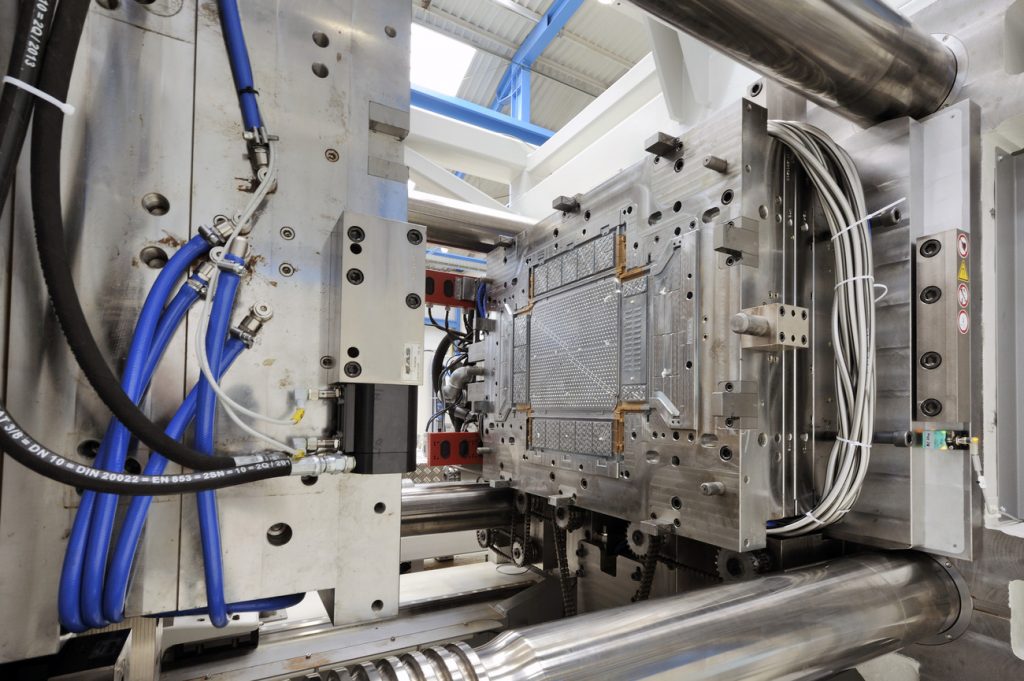Plastic injection molding is one of the most widely used manufacturing processes for producing plastic components on a large scale with high precision, efficiency, and repeatability. It involves injecting molten plastic into a mold cavity, allowing it to cool and solidify into the desired shape.
Developed in the early 20th century, the process has evolved tremendously and is now the foundation of mass production in industries such as automotive, electronics, consumer goods, packaging, medical devices, and more. The process is ideal for making complex shapes, intricate features, and products that require tight tolerances and a consistent finish.
Key Components of an Injection Molding Machine
Hopper
- A funnel-shaped container where plastic pellets (raw material) are loaded.
- Gravity feeds the material into the barrel.
Heated Barrel
- A cylindrical chamber with internal heating elements.
- Melts the plastic pellets using heat and friction generated by a rotating screw.
Screw (or Plunger)
- Moves the molten plastic forward in the barrel.
- Builds up pressure to inject the material into the mold cavity.
Nozzle
- Connects the barrel to the mold.
- Ensures smooth and controlled flow of molten plastic into the mold.
Mold
- Custom-built steel or aluminum tool made of two halves (core and cavity).
- Shapes the molten plastic into the desired form.
Injection Molding Cycle – Step-by-Step Process
Clamping
- Mold halves are closed and clamped with high pressure.
- Ensures the mold stays sealed during material injection.
Injection
- Molten plastic is injected into the mold cavity at high speed and pressure.
- The screw moves forward like a plunger to push plastic through the nozzle.
Cooling
- The plastic begins to cool and solidify inside the mold cavity.
- Cooling time depends on the material and part thickness.
Ejection
- Ejector pins push the part out of the mold.
- The mold closes again for the next cycle.
Typical cycle time: 5–60 seconds depending on part complexity and size.
Variations of Injection Molding
Overmolding
- Injecting one material over another.
- Example: Soft rubber grip over a hard plastic handle.
Insert Molding
- Placing metal or other inserts into the mold before injecting plastic around them.
- Common for threaded metal parts.
Gas-Assisted Injection Molding
- Gas (usually nitrogen) is injected to create hollow sections.
- Reduces weight and material usage.
Micro Injection Molding
- For producing tiny, high-precision components (used in medical or electronic industries).
Despite high initial tooling costs, the long-term benefits—such as fast production cycles, high accuracy, minimal post-processing, and automation compatibility—make it a preferred method for large-scale production.
Looking ahead, the industry is rapidly embracing innovation through:
- Smart manufacturing (IoT-integrated machines)
- Sustainable materials (bioplastics, recycled resins)
- Precision technologies (micro injection molding, medical-grade production)
- AI-based process optimization (improved efficiency, reduced defects)
As demand for lightweight, durable, and customized plastic parts continues to grow, plastic injection molding will remain a core manufacturing process with expanding possibilities in quality, sustainability, and application diversity.
